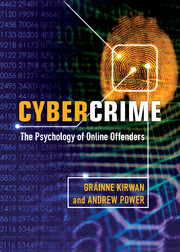Book contents
- Frontmatter
- Contents
- Detailed contents
- List of illustrations
- List of tables
- Preface
- 1 Psychology of cybercrime
- 2 Cybercrimes and cyberlaw
- 3 Hackers
- 4 Malware
- 5 Identity theft and fraud
- 6 Child predation and child pornography online
- 7 Cyberbullying and cyberstalking
- 8 Digital piracy and copyright infringement
- 9 Cyberterrorism
- 10 Crime in virtual worlds
- References
- Index
- References
2 - Cybercrimes and cyberlaw
Published online by Cambridge University Press: 05 July 2013
- Frontmatter
- Contents
- Detailed contents
- List of illustrations
- List of tables
- Preface
- 1 Psychology of cybercrime
- 2 Cybercrimes and cyberlaw
- 3 Hackers
- 4 Malware
- 5 Identity theft and fraud
- 6 Child predation and child pornography online
- 7 Cyberbullying and cyberstalking
- 8 Digital piracy and copyright infringement
- 9 Cyberterrorism
- 10 Crime in virtual worlds
- References
- Index
- References
Summary
Case studies
Mary and Tom met on a social networking site and began a friendship exchanging regular messages. After a number of months Tom suggested an offline meeting. Mary was not keen on the idea but after telling Tom he became quite upset and aggressive and began sending abusive messages to her. Mary became quite distressed and nervous about going online. In the end she had to change all of her online profiles and email addresses and was considered by her doctor to be showing some signs of stress.
John had been playing a massively multiplayer online role-playing game (MMORPG) for a number of months. In addition to investing a good deal of time in gaining a proficiency in the game, John had also spent over £150 on in-game artefacts and additional features. On his most recent visit to the online world he found that some of these goods had been stolen by another player. John was unsure about what if anything he could do about it.
Chapter overview
The first section of this chapter seeks to define the nature of online crime or cybercrime and look at the ways in which society is responding to it. We go on to look at the response and its multi-faceted nature. Governments attempt to respond with law, corporations with policies and procedures, suppliers with terms and conditions, users with peer pressure and technologists with code. The third section looks at how international laws have evolved through what is referred to as ‘soft law’ and seeks to draw lessons for the evolution of laws for the internet. The fourth section looks at the more general area of governance, examining how ideas of governance have evolved and how some of the theoretical work in this field may offer guidance for the governance of the internet. The final section examines the emerging role of social networking in online governance.
- Type
- Chapter
- Information
- CybercrimeThe Psychology of Online Offenders, pp. 28 - 50Publisher: Cambridge University PressPrint publication year: 2013



